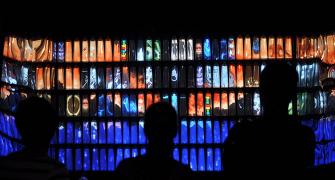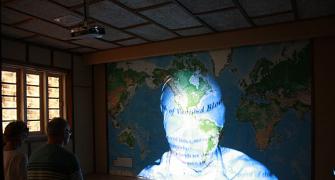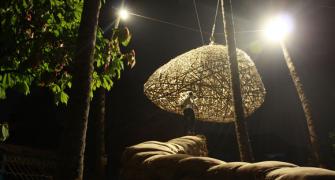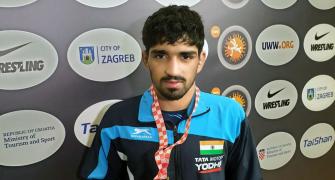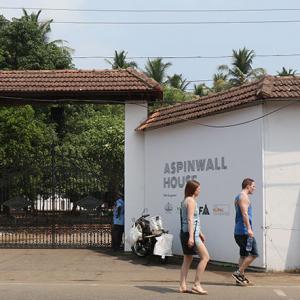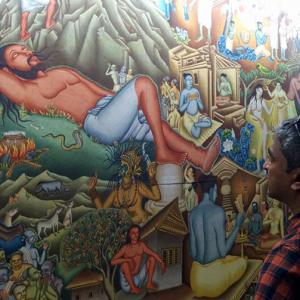How did Sudarshan Shetty, curator of the Kochi Muziris Biennale, decide what gets to be part of the show and what doesn't?
Anjuli Bhargava finds out.
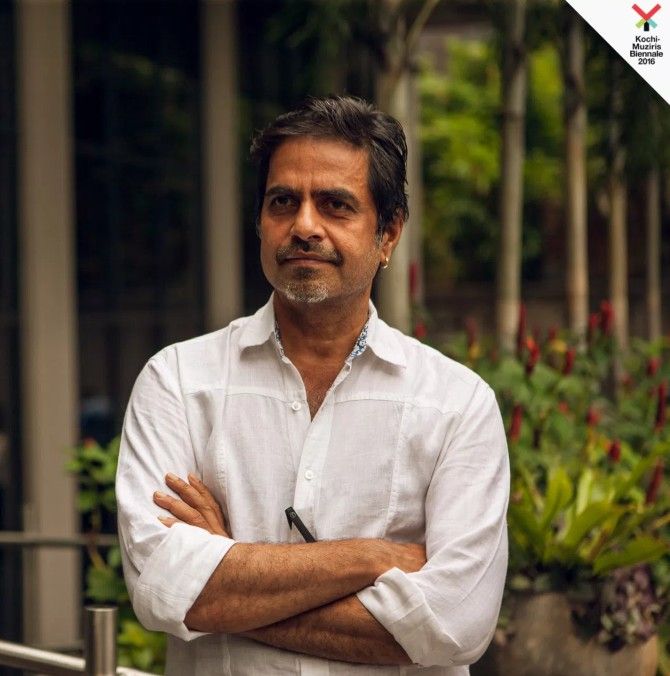
For the last four days that I have wandered around various locations that house the art installations at the Kochi art biennale, I have been eager to get into the head of the man who chose the artworks.
How does he decide what gets to be part of the show and what doesn't?
In a show as energetic, experiential and esoteric as his, what comprises good work and what doesn't?
I finally catch up with him, the curator of biennale 2016, artist and sculptor Sudarshan Shetty, at the quaint Solar Cafe in Fort Kochi.
The cafe is more like a dhaba, with rustic benches that can be shared with fellow travellers.
We manage to get a table for ourselves that protrudes out on to the extremely noisy and crowded street below.
I strain to catch the words of the soft-spoken man sitting in front of me, as speeding auto-rickshaws and car horns from below threaten to drown him out.
The third edition of the Kochi-Muziris Biennale began in December 2016 and is expected to cross 600,000 visitors from around the world over a three-and-a-half month period (December 12, 2016, to March 29, 2017).
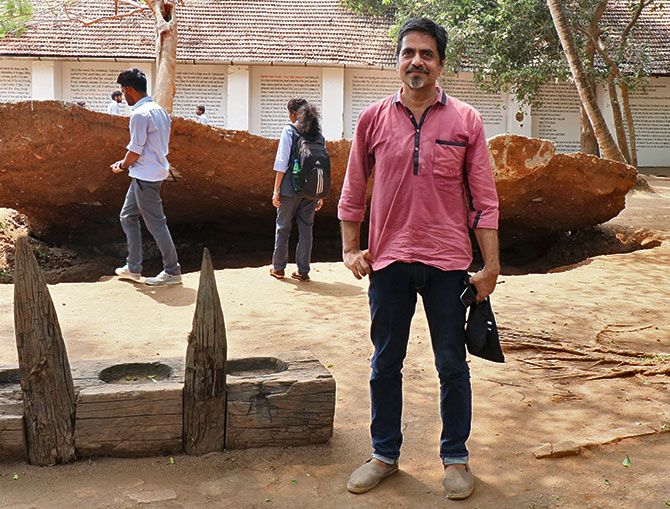
I had met Shetty at Aspinwall, one of the 12 venues where 80 per cent of the art installations this year are housed, and we had seen some artwork together. So by the time we reach our lunch venue, I am beyond the polite niceties. I get straight to the point.
"How do you choose what gets in and what doesn't?" I begin.
This, to me, is the biggest question.
What I have seen and imbibed for four days now is both thrilling and baffling. In a world full of art expressions, how does he make the final choice?
One, by first locating the art in various corners of the world.
Shetty has been travelling non-stop -- ever since he was selected to curate this edition in August 2015 -- and has visited 24 cities across the world and in India in the last 18 months.
While all expenses are paid for, the curator does his bit -- his contribution to the biennale -- gratis.
We order two vegetarian thalis. He orders a ginger lime and I a fresh juice.

Shetty says he kept himself outside the space of what is typically expected in a biennale.
He started with a lot of conversations with people outside the art world and that gave him new ideas and ways to look at work even within the sphere of art.
The first person he invited was Raul Zurita, a Chilean poet (the Sea of Pain at Aspinwall), not someone you would expect at an art festival, conventionally speaking. That's probably why you might feel baffled at the sheer breadth of what qualifies as art at the festival.
The final choices are based on a chain of events -- "a very organic kind of process".
"The idea is to see these works not as postulations within a single narrative, but to create multiple narratives that blend with each other. This is another big challenge," he adds.
I look so blank he tries again.
The biennale -- titled 'Forming in the pupil of the eye' -- has an ancient theme at its core, he explains.
When a sage opens his eye to the world, he assimilates the multiplicity of the world into that one single vision.
And the eye being the only reflective surface in the body, it reflects back what it sees. So it's a two-way process.
"Selection is always subjective from an objective distance," he explains. "You have to have an objective distance from your own practice as an artist when you judge other's works. Yet, there's no way to avoid the interests or the personality of the artist from coming into the show."
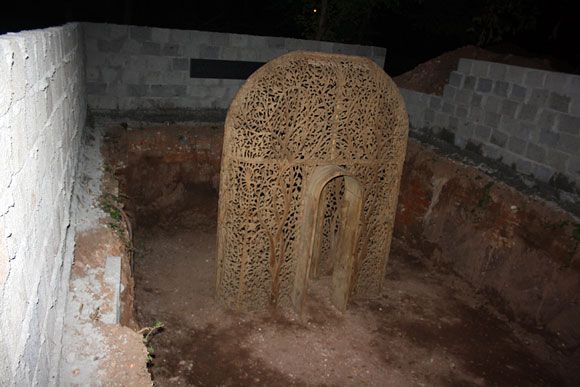
Built in three pits, it questioned the notion of constantly building memorials.
'To what extent can these memories be true to living people is anybody's guess?' he explained.
Photograph: Rajesh Karkera/Rediff.com
Does anyone -- the trustees or organisers of the festival -- have the power to veto what he chooses or rejects?
No, he has the last word.
From the time he is chosen till the end of the biennale, the curator is the boss, a position that's "fast on expiry," he jokes (expiry being the last date of the biennale).
Our thalis appear and demand attention.
There is an array of vegetables, some brown rice, papad and pickle and a large bucket of sambar and buttermilk to be shared.
There is no cutlery on offer so we eat with our hands -- something that comes naturally to him, though I am quite sloppy. We dig in.
I have some answers -- if not all -- so I move to the journey of his life.
Shetty was born in Mangalore (now Mangaluru), but he grew up in a chawl in Mumbai's Dadar where he lived with his parents -- his father was a folk artiste -- and four sisters.
At his father's insistence the five children were educated in a Kannada medium school -- something they resented because all the other children they knew went to English medium schools.
That, however, helped open up the rich world of Kannada literature and poetry to them, the value of which he can see today.
He did odd jobs -- working with a tattoo artist, doing illustrations, painting hoardings -- to finance his studies.
After finishing school, Shetty got a commerce degree from Mumbai's K J Somaiya College of Arts and Commerce, though commerce was hardly his thing.
"I never really wanted to do a degree in commerce but an art school seemed the preserve of a certain economic class to which I didn't belong," says Shetty.
Eventually, his heart won over his head and Shetty enrolled at the Sir J J School of Art for a diploma in fine arts.

Life for an artist is never smooth sailing.
After his diploma, he stayed in Mumbai for two years but didn't find a place to work out of. He moved to the Kanoria Centre for Arts in Ahmedabad and worked there for three-and-a-half years. He worked on sculptures, experimenting with materials.
A commissioned assignment brought him to Delhi, where he lived for five years. His 1995 show in the city, Paper Moon, did quite well.
"Did you sell everything you exhibited at Paper Moon?" I ask, trying to get to the bottom of how he managed financially.
Never have I met someone so unconcerned with the practicalities of life as this man.
At Paper Moon, he sold nothing.
"You need to sell, but what do you do if no one buys?" he asks, adding that it took 18 years after he finished his arts diploma to sell his first piece of work.
Along the way, he got married (in 2005) and has a four-year-old child.
How does one survive, I ask.
"That's a miracle," he says.
Those days were different and friends helped each other. Having a home to go back to also helped.
The fact that his father was an artiste (and therefore knew the value of his work) helped -- there was never any pressure on him to earn money.
"There were never any expectations -- that freed me in a way."
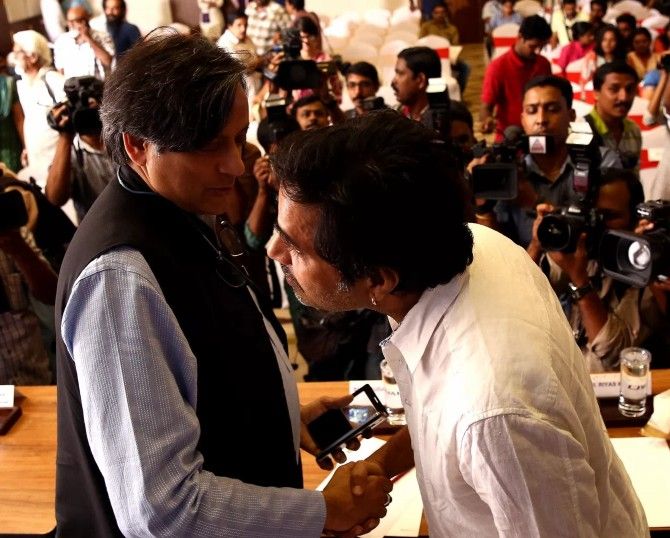
The freedom allowed him to pursue his creative instincts and develop as an artist.
To an extent, staying outside the world of commercial art is a conscious decision since, once you are in it, you are also dictated by it.
To my conventional mind, 18 years with no steady income is a rather long miracle, but Shetty is unfazed.
He never felt constrained or worried about survival as he had been managing from the time he was a child.
Despite having little, he feels his life has been rich. "I know a lot of rich people today who are much poorer."
Frugality probably runs in his veins as the choice of venue shows: Our lunch bill is Rs 470 and the food is delicious.
Paper Moon gave him greater access to the art world. "Till then, I was quite unknown," but the show got some media attention and he started to get some commissioned work.
Today, Shetty has exhibited all over the world and owns two studios in Mumbai -- one in Chembur, the other in Vikhroli (both in north-east Mumbai).
It is evident commercial success has followed him rather than the other way round.
The angst and anxiety to do "something more" drives him and for that he's grateful.
That's what keeps the artist in him -- and in anyone -- alive.


